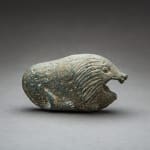Glass Sculpture of a Lion, 3000 BCE - 1500 BCE
Glass
8.9 x 19.1 cm
3 1/2 x 7 1/2 in
3 1/2 x 7 1/2 in
LO.1418
Further images
The Old Babylonian period describes south Mesopotamia in the period about 2000-1600 BC. The early years saw a number of important states dominating the region: Isin, Larsa, Eshnunna and, from...
The Old Babylonian period describes south Mesopotamia in the period about 2000-1600 BC. The early years saw a number of important states dominating the region: Isin, Larsa, Eshnunna and, from 1894 BC, Babylon. Babylon was ruled by a dynasty of Amorite kings. The sixth ruler was Hammurapi, who defeated the other southern states and expanded his control into north Mesopotamia. On the death of Hammurapi the empire gradually shrank over about 150 years. Nonetheless, Babylon remained an important power until it was sacked by the Hittite king, Mursili I, in about 1595 BC. During the Old Babylonian period literary activity flourished with scribes composing and recording religious, poetic and 'scientific' works in Sumerian and Akkadian cuneiform. Perhaps the most famous monument is the stele of Hammurapi, now in the Musée du Louvre, Paris.
For thousands of years, the lion has been a symbol of nobility and rank. To the early peoples of the Near East, the lion represented grace, power, speed, virility. This charming sculpture in glass represent a lion. Perhaps it was meant to bless the owner with the animal's virtues, or suggest social standing, or gain the protection of some god being offered in a temple. Though its past remains a mystery, its beauty and spirit are obvious.
For thousands of years, the lion has been a symbol of nobility and rank. To the early peoples of the Near East, the lion represented grace, power, speed, virility. This charming sculpture in glass represent a lion. Perhaps it was meant to bless the owner with the animal's virtues, or suggest social standing, or gain the protection of some god being offered in a temple. Though its past remains a mystery, its beauty and spirit are obvious.







